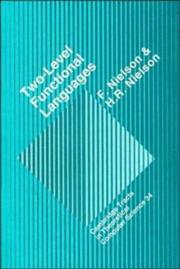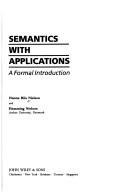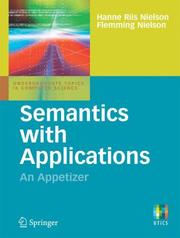| Listing 1 - 10 of 18 | << page >> |
Sort by
|
Book
Year: 1990 Publisher: Aarhus Aarhus university. Computer science department
Abstract | Keywords | Export | Availability | Bookmark
 Loading...
Loading...Choose an application
- Reference Manager
- EndNote
- RefWorks (Direct export to RefWorks)
Book
ISBN: 3030171388 303017137X Year: 2019 Publisher: Springer Nature
Abstract | Keywords | Export | Availability | Bookmark
 Loading...
Loading...Choose an application
- Reference Manager
- EndNote
- RefWorks (Direct export to RefWorks)
This book is Open Access under a CC BY licence.
Computer security. --- Software engineering. --- Artificial intelligence. --- Computer system performance. --- Computer science. --- Information theory. --- Systems and Data Security. --- Software Engineering/Programming and Operating Systems. --- Artificial Intelligence. --- System Performance and Evaluation. --- Computing Milieux. --- Theory of Computation. --- Communication theory --- Communication --- Cybernetics --- Informatics --- Science --- AI (Artificial intelligence) --- Artificial thinking --- Electronic brains --- Intellectronics --- Intelligence, Artificial --- Intelligent machines --- Machine intelligence --- Thinking, Artificial --- Bionics --- Cognitive science --- Digital computer simulation --- Electronic data processing --- Logic machines --- Machine theory --- Self-organizing systems --- Simulation methods --- Fifth generation computers --- Neural computers --- Computer software engineering --- Engineering --- Computer privacy --- Computer system security --- Computer systems --- Computers --- Cyber security --- Cybersecurity --- Electronic digital computers --- Protection of computer systems --- Security of computer systems --- Data protection --- Security systems --- Hacking --- Protection --- Security measures --- Computer system failures. --- Computers. --- Automatic computers --- Automatic data processors --- Computer hardware --- Computing machines (Computers) --- Electronic calculating-machines --- Electronic computers --- Hardware, Computer --- Calculators --- Cyberspace --- Computer failures --- Computer malfunctions --- Failure of computer systems --- System failures (Engineering) --- Fault-tolerant computing --- Failures --- Computer science --- Computer security --- Software engineering --- Artificial intelligence --- Computer system failures
Book
ISBN: 9783030171384 3030171388 Year: 2019 Publisher: Springer Nature
Abstract | Keywords | Export | Availability | Bookmark
 Loading...
Loading...Choose an application
- Reference Manager
- EndNote
- RefWorks (Direct export to RefWorks)
This book is Open Access under a CC BY licence.
Computer security. --- Software engineering. --- Artificial intelligence. --- Computer system failures. --- Computers. --- Systems and Data Security. --- Software Engineering/Programming and Operating Systems. --- Artificial Intelligence. --- System Performance and Evaluation. --- Computing Milieux. --- Theory of Computation.
Article
Abstract | Keywords | Export | Availability | Bookmark
 Loading...
Loading...Choose an application
- Reference Manager
- EndNote
- RefWorks (Direct export to RefWorks)

ISBN: 0521403847 Year: 1992 Publisher: New York (N.Y.) : Cambridge university press,
Abstract | Keywords | Export | Availability | Bookmark
 Loading...
Loading...Choose an application
- Reference Manager
- EndNote
- RefWorks (Direct export to RefWorks)

ISBN: 0471929808 9780471929802 Year: 1992 Publisher: Chichester: Wiley,
Abstract | Keywords | Export | Availability | Bookmark
 Loading...
Loading...Choose an application
- Reference Manager
- EndNote
- RefWorks (Direct export to RefWorks)

ISBN: 1846286913 1846286921 9781846286919 Year: 2007 Publisher: London : Springer London : Imprint: Springer,
Abstract | Keywords | Export | Availability | Bookmark
 Loading...
Loading...Choose an application
- Reference Manager
- EndNote
- RefWorks (Direct export to RefWorks)
Semantics will have an important role to play in the future development of software systems and domain specific languages, and there is a real need for an introductory book that presents the fundamental ideas behind these approaches; stresses their relationship by formulating and proving the relevant theorems; and illustrates the applications of semantics in computer science. Written out of a tradition that places special emphasis on operational semantics, denotational semantics and axiomatic semantics, this book investigates the relationship between the various methods and describes some of the main ideas used, illustrating these via interesting applications. Historically important application areas are used together with some exciting potential applications including: Validating prototype implementations of programming languages Verifying program analyses that are part of more advanced implementations of programming languages Verifying security analyses Verifying useful program properties including information about execution time. This is an introductory text that should serve as an appetizer to the whole area of semantics with applications.
Programming languages (Electronic computers) --- Semantics --- Semantics. --- Data processing. --- Computer science. --- Logic design. --- Programming Languages, Compilers, Interpreters. --- Logics and Meanings of Programs. --- Design, Logic --- Design of logic systems --- Digital electronics --- Electronic circuit design --- Logic circuits --- Machine theory --- Switching theory --- Informatics --- Science --- Programming languages (Electronic computers). --- Computer logic. --- Computer science logic --- Logic, Symbolic and mathematical --- Computer languages --- Computer program languages --- Computer programming languages --- Machine language --- Electronic data processing --- Languages, Artificial --- Programming languages (Electronic computers) - Semantics

ISBN: 9781846286926 9781846286919 1846286913 Year: 2007 Publisher: London: Springer,
Abstract | Keywords | Export | Availability | Bookmark
 Loading...
Loading...Choose an application
- Reference Manager
- EndNote
- RefWorks (Direct export to RefWorks)
Semantics will have an important role to play in the future development of software systems and domain specific languages, and there is a real need for an introductory book that presents the fundamental ideas behind these approaches; stresses their relationship by formulating and proving the relevant theorems; and illustrates the applications of semantics in computer science. Written out of a tradition that places special emphasis on operational semantics, denotational semantics and axiomatic semantics, this book investigates the relationship between the various methods and describes some of the main ideas used, illustrating these via interesting applications. Historically important application areas are used together with some exciting potential applications including: Validating prototype implementations of programming languages Verifying program analyses that are part of more advanced implementations of programming languages Verifying security analyses Verifying useful program properties including information about execution time. This is an introductory text that should serve as an appetizer to the whole area of semantics with applications.
Programming --- programmeren (informatica) --- Computer science --- programmeertalen --- Programming languages (Electronic computers) --- Semantics
Book
ISBN: 3030051552 3030051560 9783030051556 Year: 2019 Publisher: Cham: Springer,
Abstract | Keywords | Export | Availability | Bookmark
 Loading...
Loading...Choose an application
- Reference Manager
- EndNote
- RefWorks (Direct export to RefWorks)
This textbook is an introduction to the use of formal methods ranging from semantics of key programming constructs to techniques for the analysis and verification of programs. The authors use program graphs as the mechanism for representing the control structure of programs in order to find a balance between generality and conceptual complexity. The early chapters on program graphs and the Guarded Commands language are sufficient introduction for most readers to then enjoy a plug-and-play approach to the remaining chapters. These explain formal methods for analysing the behaviour of programs in various ways ranging from verification, via program analysis and language-based security, to model checking. The remaining chapters present language extensions with procedures and concurrency and cover their semantics. The book is suitable for advanced undergraduate and graduate courses in software development, and the text is supported throughout with exercises of varying grades of difficulty. The authors have developed an online learning environment that allows students to create examples beyond those covered in the main text, and in the book appendices they present programming projects aimed at implementing central parts of the development using the functional language F#.
Information theory. --- Software engineering. --- Theory of Computation. --- Software Engineering/Programming and Operating Systems. --- Computer software engineering --- Engineering --- Communication theory --- Communication --- Cybernetics --- Formal methods (Computer science) --- System design --- Computers. --- Automatic computers --- Automatic data processors --- Computer hardware --- Computing machines (Computers) --- Electronic brains --- Electronic calculating-machines --- Electronic computers --- Hardware, Computer --- Computer systems --- Machine theory --- Calculators --- Cyberspace

ISBN: 9781846286926 9781846286919 Year: 2007 Publisher: London Springer
Abstract | Keywords | Export | Availability | Bookmark
 Loading...
Loading...Choose an application
- Reference Manager
- EndNote
- RefWorks (Direct export to RefWorks)
Computer science --- Programming --- programmeren (informatica) --- programmeertalen
| Listing 1 - 10 of 18 | << page >> |
Sort by
|

 Search
Search Feedback
Feedback About UniCat
About UniCat  Help
Help News
News